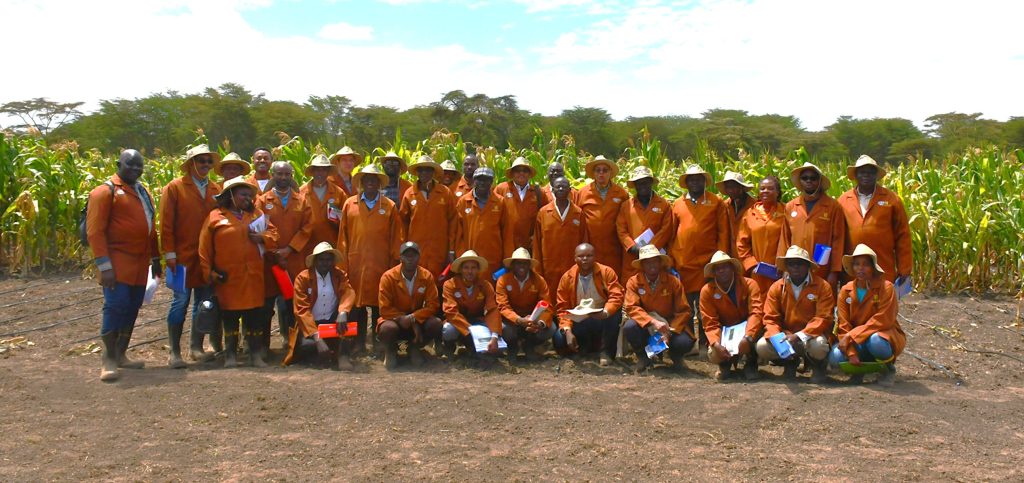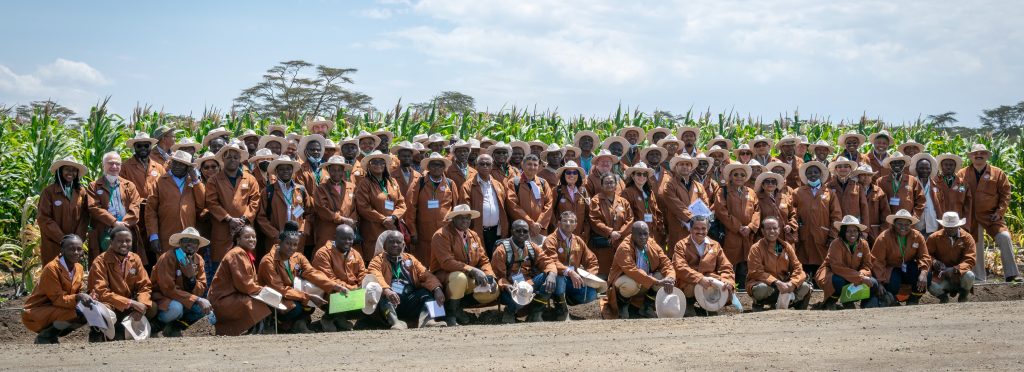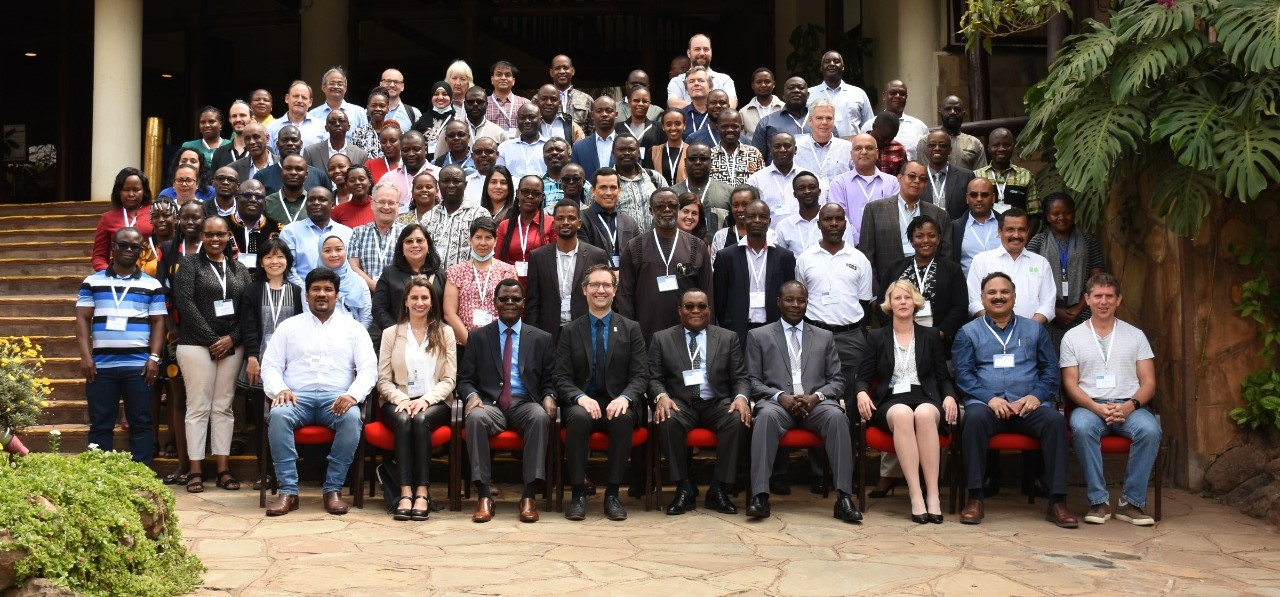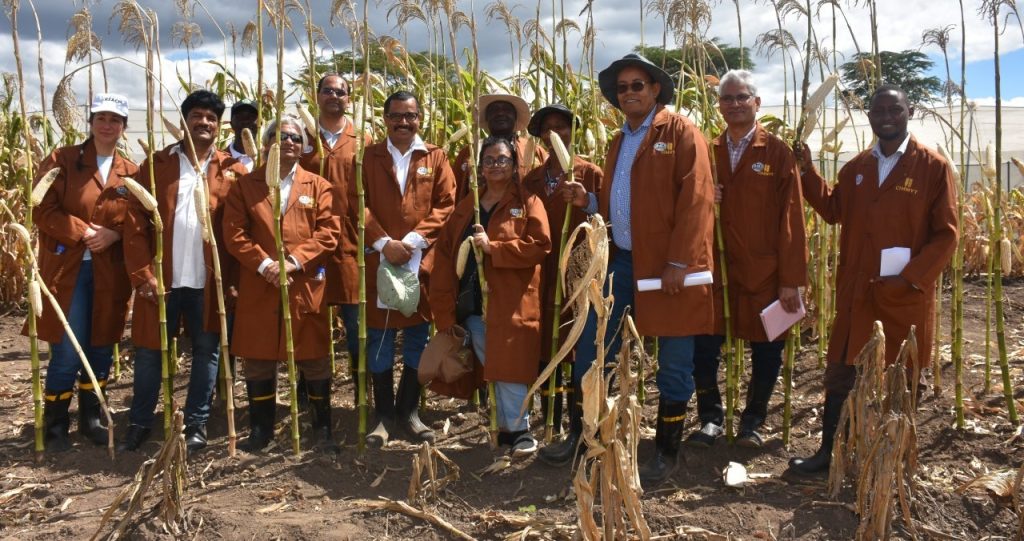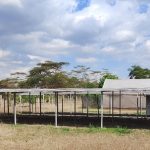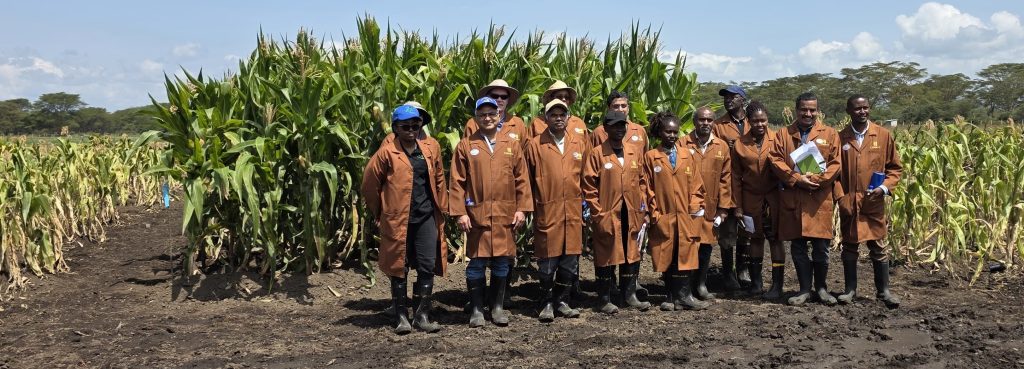
- MLN gene editing team visiting MLN gene editing efficacy trial June 2025
- International Maize Improvement Consortium (IMIC) - Africa Field Day at Naivasha, Sept, 10th 2025
- IMIC field day 2022
- AGG Field Day 2022
- PHI Inception meeting - 2022 at Nairobi, Kenya
Latest Updates
- Solar Powering Sustainability at the MLN Screening Facility
Dr. Suresh, L.M. (26th November, 2025): The MLN Screening Facility—one of the world’s largest and most advanced phenotyping hubs—has supported Africa’s fight against Maize Lethal Necrosis for over a decade, supporting more than ten NARES, twelve private seed companies, and the CGIAR system. With over 250,000 germplasm and 400,000 rows screened in ten years, the facility relies heavily on reliable irrigation, making power a major cost driver. Figure 2: Solar panels set up at MLN screening facility Figure3: Solar Panels at Borehole site at KALRO -CIMMYT area To secure long-term sustainability, a comprehensive solar power system was commissioned in early 2025 with USD 30,000 support from CtEH. Two solar units were installed: Set-up 1 at the borehole site with 75 panels generating 41.25 kW, fully powering the 30 kW Ebarra motor / Grundfos motor used to pump water to the 20-ha MLN field. Set-up 2 at the screening site includes 45 panels generating ...
- When heritage meets innovation, great things spark!
Her Excellency Gisele Fernández, Ambassador of Mexico to Kenya, at the CIMMYT – Kenya Seed Health Lab (GMP) in Nairobi (3rd November 2025). CIMMYT Kenya Welcomes Her Excellency Gisele Fernández, Ambassador of Mexico to Kenya. It was a great honor to host Her Excellency Gisele Fernández,Ambassador of Mexico to Kenya, at the CIMMYT Kenya offices in Nairobi. During her visit, Her Excellency toured the Maize Lethal Necrosis (MLN) laboratory, where she gainedfirst-hand insights into CIMMYT’s cutting-edge research and innovations strengthening Africa’sagrifood systems. The visit underscored the enduring partnership between Mexico and Kenya—a sharedvision for resilient, science-driven, and sustainable food systems. Her Excellency remarked: “Maize is deeply rooted in Mexico’s identity—it’s not just food but part ofour culture and daily life. It’s inspiring to see how equally vital this crop is for millions of families acrossAfrica, and how CIMMYT’s work continues to link our shared heritage through science and innovation.”Dr. Suresh L. M., ...
- Evidence to Impact: MLN-Resistant Maize, Farmer-Proven
From Naivasha, With Resilience: GIZ and Partners at the MLN Frontline Dr. Suresh, L.M. As part of the ABF Matching Grant Fund partners’ workshop in Nairobi, CIMMYT—together with KALRO—welcomed 40+ representatives from GIZ and allied organizations to the MLN Screening Facility in Naivasha. The brief was simple and serious: show how science, discipline, and partnership are translating into resilient maize for African farmers. We walked the group through the full arc—from rigorous phenotyping and IMIC-Africa collaborative trials to gene-editing pipelines targeting durable resistance. In the field lab, teams handled MCMV immunostrips and saw how simple diagnostics power real-time surveillance. On the operations side, we unpacked MLN-free seed production protocols, capacity-building modules, and live inoculation procedures that make “clean at the source” more than a slogan. Visitors came to see the engine, not the brochure: facility workflows, experimental nurseries, IMIC trials, gene-editing plots. Their questions cut to the chase—West Africa’s risk profile, timelines for ...
- IMIC-Africa Field Days 2025: Partners Share Insights on Innovation and Collaboration
IMIC-Africa Field Days 2025 united partners to explore elite maize hybrids and advance resilient, high-yield innovations for African farmers By Maria Monayo and Dr. Suresh, L.M. November 6, 2025 (Photo: CIMMYT/Maria Monayo) The Annual International Maize Improvement Consortium for Africa (IMIC-Africa) Field Day brought together seed companies, breeders, and researchers from across the continent to explore maize innovations and strengthen collaboration. Over the two days at KALRO-CIMMYT’s Kiboko and Naivasha research stations, participants observed over 800 lines of elite hybrids, selected promising lines, and shared perspectives on the future of maize breeding in the region. Field selections at Kiboko: Seeing and choosing firsthand At Kiboko, rows of trial plots showcased CIMMYT maize hybrids bred for resilience and productivity. Participants evaluated materials spanning the breeding pipeline — from early-stage experimental lines to advanced hybrids close to commercialization — ensuring that companies could select options that fit their local conditions and farmer needs. Selections focused on traits most critical ...
- Cross-Continental Learning: Indian Maize Scientists Visit CIMMYT-Kenya Under ICAR-CIMMYT Collaboration
By L.M. Suresh, CIMMYT, Nairobi, Kenya, and P.H. Zaidi, CIMMYT, Hyderabad, India In September 2025, a team of four scientists from the Indian Maize Program embarked on a transformative journey to the Global Maize Program (GMP) at CIMMYT in Kenya, organized under the ICAR-CIMMYT collaborative program on maize. The delegation included Sunil Neelam and Bhupender Kumar from ICAR-Indian Institute of Maize Research (ICAR-IIMR), Ludhiana, Jayasudha S. from Banaras Hindu University (BHU), Varanasi, and Sunil R. Karad from Mahatma Phule Krishi Vishwavidyalaya (MPKV), Maize Station at Kolhapur. The week-long visit, held from 22-28 September, formed part of an advanced training-cum-exposure program aimed at strengthening collaborative research betweenICAR and CIMMYT. The visit took place across several key GMP research stations in Kenya, each showcasing cutting-edge technologies and practices in maize breeding, precision phenotyping, and pest and disease management. From the bustling laboratories in Nairobi to the remote fields of Naivasha and Kiboko, ...
- Partners in Resilience: Co-developing Stress-Ready Maize for Africa
IMIC-Africa Field Day | Turning MLN from crisis to comeback Dr. Suresh,L.M. (10th Sep 2025) : Maize still carries dinner on its back for 200M+ households across sub-Saharan Africa, yet yields keep taking punches from drought, foliar complexes, and—let’s be honest—the heavyweight champ of disruption this past decade: Maize Lethal Necrosis (MLN). It hasn’t just slashed harvests; it has jammed seed movement and rattled confidence across markets. That’s why, back in 2018, CIMMYT doubled down with IMIC-Africa—a public–private engine designed the old-fashioned way (clear roles, shared protocols, field rigor) but tuned for modern speed (data pipes, fast go/no-go, and clean-seed discipline). The result? A living proof-point that when NARES, NPPOs, and seed companies pull in one direction, resilience stops being a slogan and starts being a supply. At the heart of this partnership sits the Naivasha MLN platform, co-run with KALRO—a world benchmark where rigor isn’t a buzzword, it’s the air everyone ...

